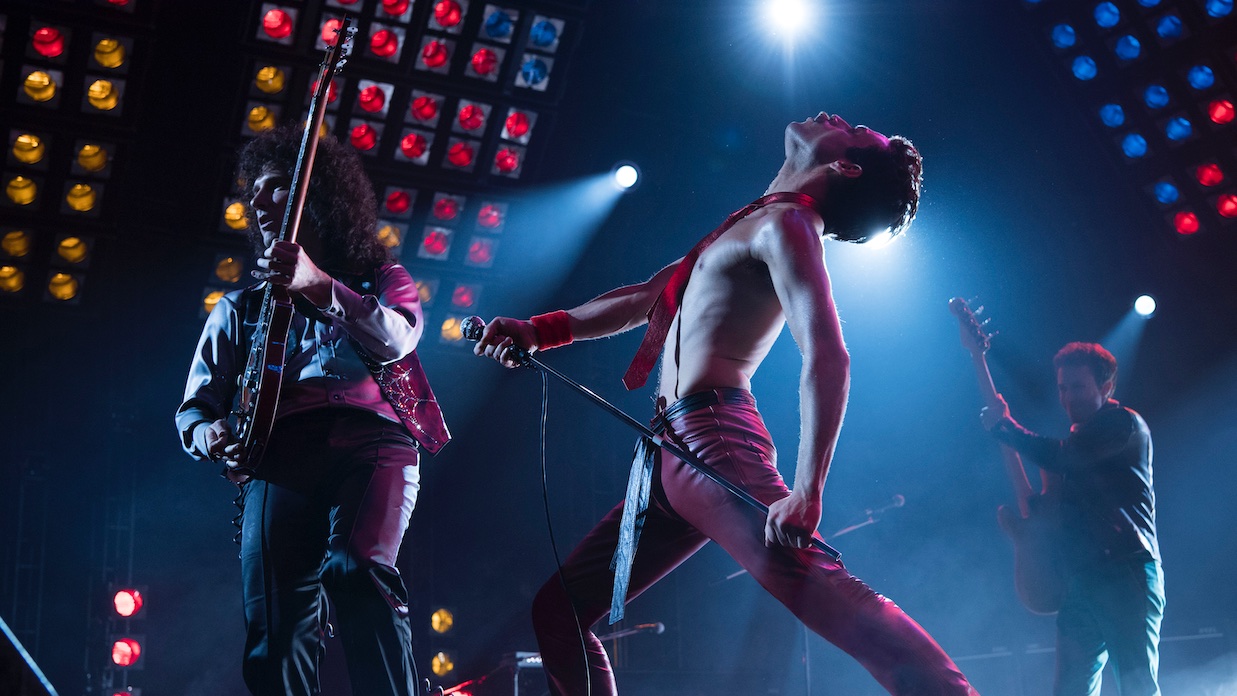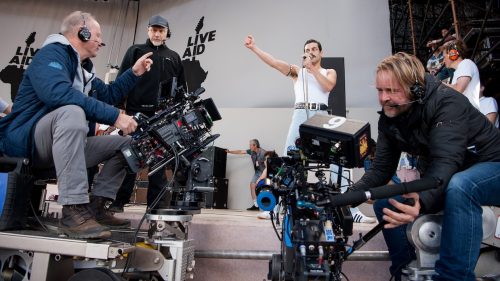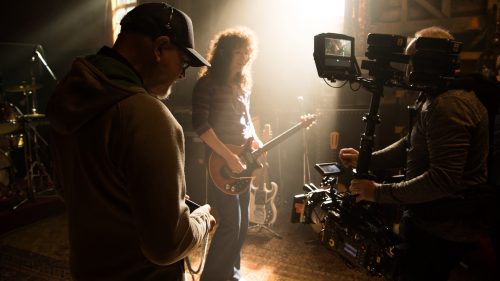 Back to selection
Back to selection
Shutter Angles
Conversations with DPs, directors and below-the-line crew by Matt Mulcahey
“Like Most Looks in Film, It’s a Bit of a Recipe”: Cinematographer Newton Thomas Sigel on Using Varying Cameras, Lenses and LUTs on Bohemian Rhapsody
 L-R: Gwilym Lee (Brian May), Rami Malek (Freddie Mercury), and Joe Mazzello (John Deacon) star in Twentieth Century Fox’s BOHEMIAN RHAPSODY. Courtesy Twentieth Century Fox.
L-R: Gwilym Lee (Brian May), Rami Malek (Freddie Mercury), and Joe Mazzello (John Deacon) star in Twentieth Century Fox’s BOHEMIAN RHAPSODY. Courtesy Twentieth Century Fox. If you’re a fan of the music of the 1970s, your favorite artist may soon have a biopic on the way. An Elton John flick is already en route. We’ll probably get a Bowie movie. Maybe Zeppelin. I’m crossing my fingers for The Jim Croce Story.
You can thank Bohemian Rhapsody for that potential onslaught. The Queen biopic has grossed more than $600 million worldwide so far on a budget of roughly $50 million. With the film still out in theaters, cinematographer Newton Thomas Sigel (Drive, Three Kings, The Usual Suspects) spoke to Filmmaker about recreating Queen’s epic concert lighting, using different lenses and LUTs to capture different periods, and his early days working with John Sayles and Haskell Wexler.
Filmmaker: I didn’t realize until looking at your credits that you had this career shooting 2nd Unit in the 1980s on movies like Platoon and Wall Street. Any stories you can share about working on Matewan (1987) with John Sayles and cinematographer Haskell Wexler?
Sigel: John Sayles is an amazing filmmaker. He’s a great human being too. For so many years he’s made these movies for very humble budgets that were done with complete integrity. To work with him and Haskell, those are two legendary artists. At that point I had shot [the 1985 Nicaragua set drama] Latino for Haskell so I knew him pretty well. It was interesting to watch the two of them work. John was very clear about what he wanted. He had it all in his head. I think that Haskell, who really was kind of a frustrated director as well as a shooter, often found that hard because he kept wanting to go off the path that John had in his mind. But they really did come together at the end of the day on the intent of the movie on both a political level and a filmmaking level.
Filmmaker: Sayles wrote a book about the making of that movie called Thinking In Pictures. I bought it a couple years ago but haven’t gotten around to it yet.
Sigel: My favorite moment was when I did a shot for Haskell where I was sitting on a piece of wood sticking out the window of a train. I was shooting a close-up of Chris Cooper with the camera on my shoulder. We were going along and all of a sudden the train came to a screeching halt and everybody came running at me and they were all pointing. I was like, “Why did we stop? That was a great shot.” Then I looked over my shoulder and there was a tunnel. (laughs) If we had kept going the wood would’ve hit the tunnel and I wouldn’t be having this interview with you.

Filmmaker: Let’s get into Bohemian Rhapsody. It covers a span of about 15 years and there’s a very noticeable shift in the aesthetic as time passes.
Sigel: The movie starts and ends with (Queen’s performance at) Live Aid in 1985, so that’s sort of the framing device, and after that tease of Live Aid we go back to 1970 and work our way through the story (chronologically). In the early scenes set in 1970, Freddie has just gotten to London and he’s a fish-out-of-water immigrant who’s infatuated with the counterculture music scene. That section of the film was shot all handheld on the Alexa SXT with the old (Cooke) Speed Panchro lenses. They have been rehoused, but it’s the old glass and old coatings. We also used some light netting on the back of the lens.
Lighting wise, the instruments that we used were pretty much the same [across the different time periods]. What I did do was stay as true as possible to the period lights for all of the live music performances. So in the beginning it’s 1970 when Freddie first performs in the movie and all of that stuff was done with period appropriate lighting, which was basically par cans and a couple of color wheels, which were circular filters with different colored gels that you could rotate through the light so it would change color. That was the 1970 version of LEDs. (laughs) The lighting evolves from those humble beginnings as the scale of the concerts goes up one step at a time until Queen gets to Madison Square Garden and performs “We Will Rock You.” I tried to reproduce the massive lighting rigs that Queen was famous for as faithfully as I could and I stayed pretty truthful to what I discovered in archival footage. They were a very early adopter of the Vari-Lite. Genesis was one of the investing bands that really made that light become possible and Queen quickly adopted it.
Filmmaker: For those early 1970s scenes, how did you get the bloom in the highlights?
Sigel: Like most looks in film, it’s a bit of a recipe. It’s not just one thing. There was a LUT created particularly for that period. Lighting wise, there was always an emphasis on having the highlights fairly radically overexposed. We often had a source that was really pounding into the scene and then between the LUT and the filtration you get this slight halation in highlights and it was emphasized by shooting at very wide open stops.
Filmmaker: And as we get into the late 1970s/early 1980s, how does the look change?
Sigel: We switched to the Alexa 65 and shot in Open Gate with Arri Prime DNA lenses with no nets. The LUT was quite different as well. It’s a much more desaturated, cooler look. Those lenses are also inherently sharper and the larger format (of the Alexa 65) has more picture detail. It’s kind of a cleaner look, so to speak.

Filmmaker: Did you do lens test for the Alexa 65? What are your choices right now in terms of glass that will cover that format?
Sigel: I looked at the Arri Prime 65’s, which I used on my previous movie, and I also looked at some Panavision glass like the Spheros and the Ultra Panatars. The DNA’s [juxtaposed against] the Speed Panchros just gave me the visual journey that felt right for the movie.
Filmmaker: Bohemian Rhapsody is 2.39, but shot spherically. Did you think about going anamorphic?
Sigel: I did. I’ve done my fair share of anamorphic [projects]. I love the Panavision E Series lenses and recently I did something with the Hawk Vintage ‘74’s that was really beautiful. But I kind of settled in on the DNA and the Alexa 65 combo as the best recipe for what I was trying to get.
Filmmaker: The resolution of the Alexa 65 in Open Gate mode is 6.5K. The SXT in Open Gate is 3.4K. When you get into the DI, can you tell a significant difference between the cameras in how much you can alter the image?
Sigel: The difference I see is that [the 65] has more subtle picture detail. I could see it in things like the wardrobe, the textures in the fabrics. That’s where I noticed the difference. The Alexa XT has filmed some of the most beautiful movies of the last five years so it’s not like amazing images can’t be had with it. To me it’s really less about the quantity of pixels than the quality of them and the 65 is really just three of Arri’s Alexa sensors put together vertically. In terms of moving [the image] around, we had a pretty good look for the movie already dialed in when we went into the DI. So there wasn’t a lot of deviating from what we had set in the dailies. Having said that, I think you can probably push around an SXT image as much as you can push around an Alexa 65.
Filmmaker:One scene that I haven’t heard you talk about yet is the press conference as the band begins to break apart. We get this distorted point of view from Freddie. How did you achieve that look?
Sigel: Queen was never a darling of the critics, and actually Freddie Mercury and the band had been kind of lambasted by a lot of them. So the band had a slightly antagonistic relationship already with music critics. At that stage in our story, Freddie was going down a decadent road in his own life. He was starting to wonder whether he should be doing something on his own instead of with the band. All of this stuff was percolating within him. He was drinking more and at that press conference there are a lot of hard questions and things get more and more antagonistic as it goes on. So I was looking for a way to create this idea of Freddie being a little off-kilter at the beginning of the press conference and as the stress gets worse and worse he starts to lose it and has this strange out-of-body experience. The early set-up of the scene is done relatively conventionally and then as he starts freaking out his point of view becomes more and more distorted. We looked at a number of lenses that Arri had, weird trick lenses like the old Petzvals, and the thing that I settled on that really worked the best was a Zeiss 35mm lens with reverse optics, which is where one of the elements is [flipped], and it creates this weird distortion that bleeds out toward the edges of the frame. Lenses are designed to take light rays and bend them into your negative or in this case your sensor in a very precise, parallel way. By turning the glass around you start to get some of the rays at the edges of the frame that should be bending in toward the center that are actually going in the opposite direction. It’s particularly fun when you pan the camera because it’s almost like the distortion ripples across the frame. That really became the hero lens of that sequence. The build up to it was really enhanced and helped by the editor, John Ottman, who was able to construct a rhythmic deterioration of the point of view.
Filmmaker: The movie culminates in a comeback performance by Queen at Wembley Stadium for Live Aid. Queen’s actual Live Aid set was around 20 minutes and it feels like you cover most of it.
Sigel: The movie leaves out “We Will Rock You,” because we’ve seen that song earlier in the movie, and it leaves out “Crazy Little Thing Called Love,” because everybody thinks that is an Elvis cover. Otherwise it’s the full concert. It was the first thing that we shot and I think we had seven days to do it in and that included the backstage work where you see the band getting ready and then coming up on stage.
The storytelling challenge was that this is the climactic scene yet the stage at Live Aid was purposefully not dramatic because the promoters of the concert didn’t want anything ostentatious. They wanted it to be sparse so all the money would go to the charity they were raising money for. So we’re going from these incredible concerts like Madison Square Garden to a show in the daylight without much stage lighting and a plain grey backing — and it’s supposed to be the most dramatic scene in the movie.
Our schedule also dictated that we shoot a different song each day, rather than controlling the light so that we were always shooting a certain song at a certain time each day. I initially wanted to put up a big silk, but that was deemed too expensive. It was definitely a challenge, particularly when you’re starting your show that way and the crew is still trying to figure each other out and the movie is trying to figure itself out, but that scene seems to be one of the hallmarks of the movie that people really love.
Matt Mulcahey works as a DIT in the Midwest. He also writes about film on his blog Deep Fried Movies.
